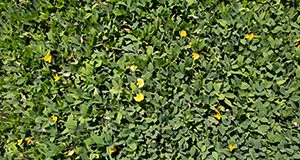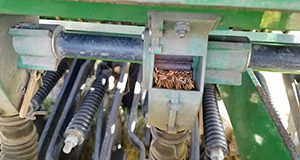Determining forage moisture is an essential procedure for estimating forage mass in pastures, determining harvesting or baling point for preserved forages, and calculating dry matter of feedstuff for total mixed rations. This 3-page document discusses methods and pieces of equipment available to estimate forage moisture. Written by M. Wallau and J. Vendramini, and published by the UF/IFAS Agronomy Department, revised June 2019.
http://edis.ifas.ufl.edu/ag181
Tag: Florida Forage Handbook
Calibrating Forage Seeding Equipment
Establishing forages from seeds often requires precision equipment to achieve specific seeding rates for a proper pasture stand. Most pieces of equipment have calibration charts, which are useful guides for making an initial setting. However, due to variations in seed size, purity, moisture content, equipment performance, ground speed, and other factors, calibrating equipment prior to each use is recommended. This 5-page document discusses a few calibration techniques for drills and broadcast spreaders. Written by Marcelo Wallau, Joao Vendramini, and Ed Jennings, and published by the UF/IFAS Agronomy Department, revised November 2018.
http://edis.ifas.ufl.edu/ag158
Rhizoma Perennial Peanut (SSAGR349/AG358)
 Rhizoma perennial peanut is a forage legume available to Florida producers that combines high nutritive value (comparable to alfalfa) with persistence under a wide range of management conditions. It can be used for hay production, silage, or grazing. Find out more in this 4-page fact sheet was written by M.J. Williams, Y.C. Newman, and Ann Blount, and published by the UF Department of Agronomy, June 2011.
Rhizoma perennial peanut is a forage legume available to Florida producers that combines high nutritive value (comparable to alfalfa) with persistence under a wide range of management conditions. It can be used for hay production, silage, or grazing. Find out more in this 4-page fact sheet was written by M.J. Williams, Y.C. Newman, and Ann Blount, and published by the UF Department of Agronomy, June 2011.
http://edis.ifas.ufl.edu/ag358
Florida Forage Handbook: Preface (SSAGR98/AG171)
 This revised 2-page fact sheet introduces the new edition of the Florida Forage Handbook which has become the go-to-guide for every Florida forage enthusiast, new or seasoned, and now contains updated and expanded information most relevant to today’s livestock producer and forage manager. Written by Y.C. Newman and C.G. Chambliss, and published by the UF Department of Agronomy, April 2011.
This revised 2-page fact sheet introduces the new edition of the Florida Forage Handbook which has become the go-to-guide for every Florida forage enthusiast, new or seasoned, and now contains updated and expanded information most relevant to today’s livestock producer and forage manager. Written by Y.C. Newman and C.G. Chambliss, and published by the UF Department of Agronomy, April 2011.
http://edis.ifas.ufl.edu/ag171
SSAGR177/AG180 Silage Harvesting, Storing, and Feeding
Revised! SS-AGR-177, an 8-page illustrated fact sheet by A. T. Adesogan and Y. C. Newman, discusses the advantages, disadvantages and phases of silage fermentation and the factors affecting silage quality. Published by the UF Department of Agronomy, September 2010.
http://edis.ifas.ufl.edu/ag180
SSAGR65/AA216 Pastures and Forage Crops for Horses
Revised! SS-AGR-65, an 8-page fact sheet by Y. C. Newman, E. L. Johnson, J. Vendramini, C. Chambliss, and I. V. Ezenwa, discusses site selection, stocking rate, varieties, and pasture management for horses. Published by the UF Department of Agronomy, September 2010.
http://edis.ifas.ufl.edu/aa216
SSAGR94/AG162 General Guidelines for Managing Pastures for Dairy Cows
Revised! SS-AGR-94, a 4-page illustrated fact sheet by L. E. Sollenberger, Y.C. Newman, and J.M.B. Vendramini, is part of the Florida Forage Handbook. It answers dairy producers’ questions about managing pasture as a major source of nutrients for milking cows — soil testing and pasture fertilization, choice of forage species, and grazing strategies. Published by the UF Department of Agronomy, June 2009.
http://edis.ifas.ufl.edu/AG162
SSAGR71/AA255 Forage Grasses for Florida’s Organic Soils
Revised! SS-AGR-71, a 3-page fact sheet by I. V. Ezenwa, R. M. Muchovej and F. M. Pate, is part of the Florida Forage Handbook. It highlights the two forage grasses recommended for the fertile organic soils of the Everglades Agricultural Area (EAA) — St. Augustinegrass and Limpograss. Includes references. Published by the UF Department of Agronomy, March 2009.
http://edis.ifas.ufl.edu/AA255
SSAGR63/AA192 Forage Testing
Revised! SS-AGR-192, a 4-page fact sheet by J.M. Vendramini, M.S. Silveira, J. D. Arthington, and A. R. Blount, provides basic information about forage testing procedures at the UF/IFAS Forage Extension Testing Laboratory, where to send samples, how to interpret the testing results and how to collect a sample. Includes references. Published by the UF Department of Agronomy, February 2009.
http://edis.ifas.ufl.edu/AA192

